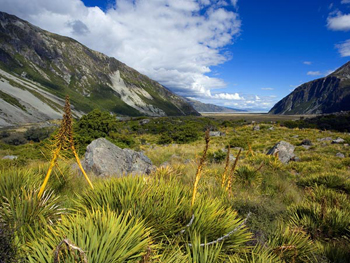Warm Snap Turned Antarctica Green Around the Edges
 Icy Antarctica may once have resembled modern-day South Island, New Zealand, seen to the right.
Icy Antarctica may once have resembled modern-day South Island, New Zealand, seen to the right.An unexpectedly warm period about 15 million years ago temporarily thawed Antarctica, turning the continent green around its edges, a new study says.
Antarctica developed its ice sheets about 34 million years ago. But during the more recent warm period, the interior landscape would’ve resembled tundra found in parts of modern-day Chile and New Zealand, and the coasts would’ve been lined with beeches and a type of conifer.
The surprising evidence comes from “abundant” remains of leaf waxes in sediment cores taken from deep beneath Antarctica’s Ross Ice Shelf, said study leader Sarah Feakins, a biogeochemist at the University of Southern California.
The sediments had blown off Antarctic soils into the ocean during the Miocene, a mild period in Earth’s history between about 15 and 20 million years ago.
Not only were the leaf wax remnants numerous—suggesting many plants were growing on Antarctic coasts—but an analysis of their chemistry revealed the continent was warmer than thought, Feakins said.
Previous research from sediment cores hinted that Antarctica was about five degrees Fahrenheit (three degrees Celsius) warmer on average during the Miocene than it is today.
But the new study revealed that Antarctic temperatures were 20 degrees Fahrenheit (11 degrees Celsius) warmer—which means the Antarctic coast would have been about 45 degrees Fahrenheit (7 degrees Celsius) on a summer day.
“We knew the Miocene was a warm period, but it was a surprise to see how warm it got,” Feakins said.
Leaf Waxes Reveal Ancient Climate
When a plant dies, most of it decomposes, except for pollen grains and the waxes on its leaves. The leaf wax can then get trapped and preserved in sediment as a kind of “molecular fossil,” Feakins said.
For the new study, Feakins and colleagues extracted plant waxes from the Miocene sediment cores and put them in a mass spectrometer, which separates out isotopes—variations of chemicals that have different masses.
Leaf waxes keep climate records by capturing the ratios of water isotopes that a plant “drank” while it was alive, said Feakins, whose study was published online June 17 in the journal Nature Geoscience.
Normally the lightest element on the periodic table, hydrogen has a stable isotope called deuterium that’s twice as heavy as regular hydrogen.
When it rains, water made from deuterium falls out first, leaving the lighter isotope in the cloud.
“Today the precipitation that falls over Antarctica is some of the lightest, isotopically speaking, because evaporation happens in the subtropics, and the cloud is almost all rained out by the time it gets to Antarctica,” Feakins explained.
But the team found more deuterium preserved in the ancient plant waxes.
Combining that data with atmospheric models, the team concludes that the Miocene’s warmer oceans led to increased evaporation, so that clouds were more water-laden, and thus produced more rainfall, by the time they traveled to the Antarctic coast.
Pollen grains also found in the sediments revealed two tree species: the beech Nothofagus fusca and a shrubby conifer in the genus Podocarpidites.
Tree species vary in how far their pollen grains can be transported from the plant. Neither N. fusca nor Podocarpidites grains can travel far, which shows that the trees must have grown on Antarctica and not, say, on the more distant coasts of New Zealand.
And if the trees had grown far inland on Antarctica, the pollen would not have been found in coastal sediments.
Modern Warming Insights
Although the Miocene was generally warmer than it is today, the new research may have some relevance to the current trend of global warming, Feakins noted.
Earth’s average global temperature has increased by about 1.4 degrees Fahrenheit (0.8 degree Celsius) since 1880, according to NASA’s Goddard Institute for Space Studies. Two-thirds of that warming has happened since 1975.
Understanding Miocene rainfall patterns may help scientists figure out how much wetter it will get as the world gets hotter, the study authors say.
Overall, warming-related changes to the global water cycle are “really troubling [because] it’s just not easy or inexpensive for societies to adjust to big changes in water supply,” Mark Pagani, a biogeochemist at Yale University who wasn’t on the study team, said via email.
And the new research suggests there will be “substantial” shifts in the water cycle—making areas either rainier or drier—due to current temperature changes, he said.
“I realize that for most folks, stories about the Earth 20 million years ago sound very abstract,” he added.
“But in terms of the Earth and climate, this [Antarctic warming] was not very long ago, and the distribution of the continents and chemistry of the atmosphere was actually not very different than today.”
You can return to the main Market News page, or press the Back button on your browser.

